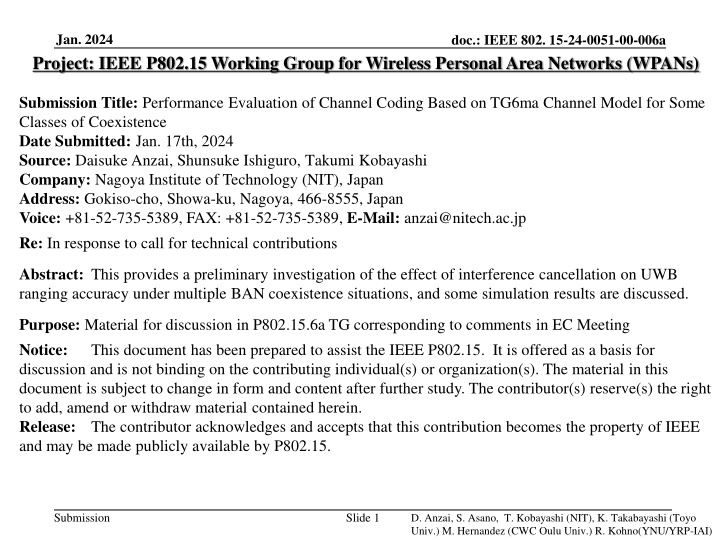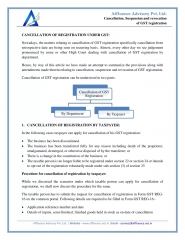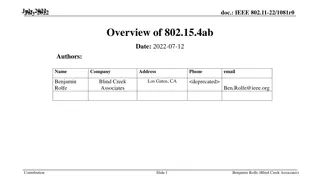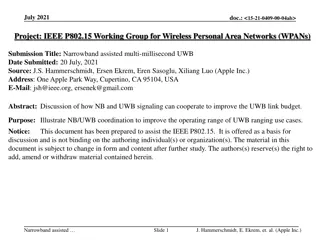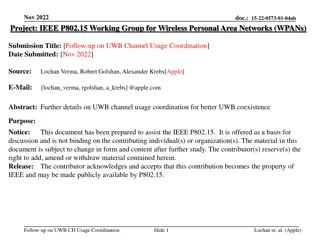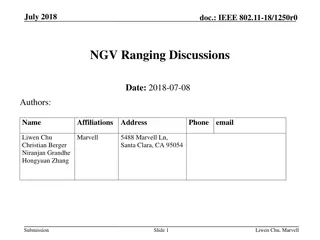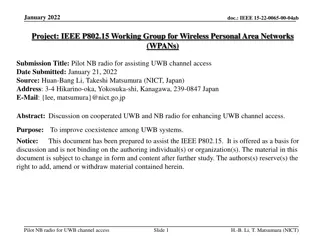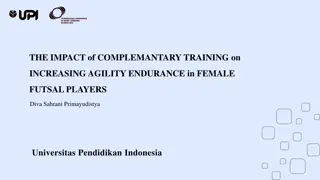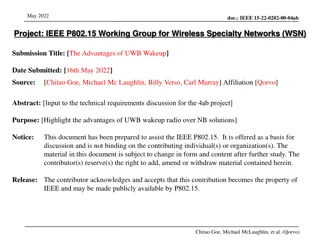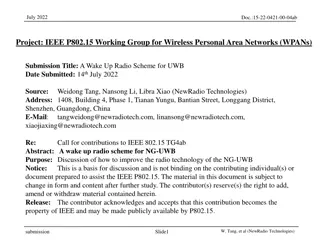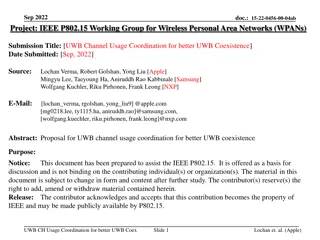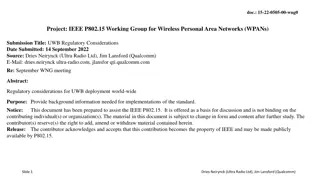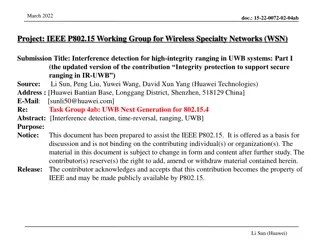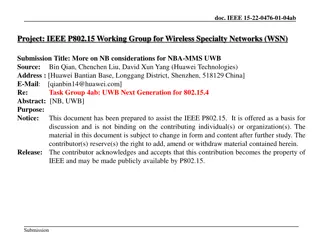Preliminary Investigation of Interference Cancellation in UWB Ranging Accuracy
This document presents a preliminary investigation on the impact of interference cancellation on Ultra-Wideband (UWB) ranging accuracy under multiple Body Area Network (BAN) coexistence scenarios. It discusses simulation results related to the performance evaluation of channel coding based on TG6ma channel model for certain classes of coexistence, highlighting the importance of quality of service (QoS) control in Wireless Body Area Networks (WBANs).
Download Presentation

Please find below an Image/Link to download the presentation.
The content on the website is provided AS IS for your information and personal use only. It may not be sold, licensed, or shared on other websites without obtaining consent from the author.If you encounter any issues during the download, it is possible that the publisher has removed the file from their server.
You are allowed to download the files provided on this website for personal or commercial use, subject to the condition that they are used lawfully. All files are the property of their respective owners.
The content on the website is provided AS IS for your information and personal use only. It may not be sold, licensed, or shared on other websites without obtaining consent from the author.
E N D
Presentation Transcript
Jan. 2024 Project: IEEE P802.15 Working Group for Wireless Personal Area Networks (WPANs) doc.: IEEE 802. 15-24-0051-00-006a Submission Title: Performance Evaluation of Channel Coding Based on TG6ma Channel Model for Some Classes of Coexistence Date Submitted: Jan. 17th, 2024 Source: Daisuke Anzai, Shunsuke Ishiguro, Takumi Kobayashi Company: Nagoya Institute of Technology (NIT), Japan Address: Gokiso-cho, Showa-ku, Nagoya, 466-8555, Japan Voice: +81-52-735-5389, FAX: +81-52-735-5389, E-Mail: anzai@nitech.ac.jp Re: In response to call for technical contributions Abstract: This provides a preliminary investigation of the effect of interference cancellation on UWB ranging accuracy under multiple BAN coexistence situations, and some simulation results are discussed. Purpose: Material for discussion in P802.15.6a TG corresponding to comments in EC Meeting Notice: This document has been prepared to assist the IEEE P802.15. It is offered as a basis for discussion and is not binding on the contributing individual(s) or organization(s). The material in this document is subject to change in form and content after further study. The contributor(s) reserve(s) the right to add, amend or withdraw material contained herein. Release: The contributor acknowledges and accepts that this contribution becomes the property of IEEE and may be made publicly available by P802.15. Submission Slide 1 D. Anzai, S. Asano, T. Kobayashi (NIT), K. Takabayashi (Toyo Univ.) M. Hernandez (CWC Oulu Univ.) R. Kohno(YNU/YRP-IAI)
Jan. 2024 doc.: IEEE 802. 15-24-0051-00-006a Performance Evaluation of Channel Coding Based on TG6ma Channel Model for Some Classes of Coexistence Daisuke Anzai, Sho Asano, Kento Takabayashi, Takumi Kobayashi, Marco Hernandez, Ryuji Kohno Nagoya Institute of Technology (NIT) Toyo University, YNU, YRP-IAI, CWC Oulu Univeristy Submission Slide 2 D. Anzai, S. Asano, T. Kobayashi (NIT), K. Takabayashi (Toyo Univ.) M. Hernandez (CWC Oulu Univ.) R. Kohno(YNU/YRP-IAI)
Jan. 2024 doc.: IEEE 802. 15-24-0051-00-006a Importance of QoS control In WBAN systems, a wearable vital sign sensor node can include various types of sensors with different data rates, the allowable communication error ratio and delay User priority Traffic designation Frame type 0 Background (BK) Data 1 Best effort (BE) Data 2 Excellent effort (EE) Data IEEE 802.15.6 based WBAN may deal with 8 levels of user priority data 3 Video (VI) Data 4 Voice (VO) Data 5 Medical data or network control Data or management Those data have a wide range of quality of service (QoS) 6 High-priority medical data or network control Data or management 7 Emergency or medical implant event report Data Therefore, optimal error control for input data is an important feature in sensor data transmission procedures Submission Slide 3 D. Anzai, S. Asano, T. Kobayashi (NIT), K. Takabayashi (Toyo Univ.) M. Hernandez (CWC Oulu Univ.) R. Kohno(YNU/YRP-IAI)
Jan. 2024 doc.: IEEE 802. 15-24-0051-00-006a Error control in current IEEE 802.15.6 IEEE 802.15.6 shall use a (63, 51) BCH code as an error correcting code in narrowband, UWB and HBC PHY Only user priority 6 data in UWB-PHY may use a hybrid ARQ with a (126, 63) shortened BCH code However, the error control scheme of the current IEEE 802.15.6 cannot deal with the QoS because of lack of flexibility In IEEE 802.15.6ma, we indicate a concept of channel coding technique to deal with various types of QoS data as shown in a next figure Submission Slide 4 D. Anzai, S. Asano, T. Kobayashi (NIT), K. Takabayashi (Toyo Univ.) M. Hernandez (CWC Oulu Univ.) R. Kohno(YNU/YRP-IAI)
Jan. 2024 doc.: IEEE 802. 15-24-0051-00-006a Forward error correcting codes in TG6ma User priority Inner code Outer code HARQ 0 15.4ab LDPC or BCC (R=1/2) - 1 15.4ab LDPC or BCC (R=1/2) - 2 15.4ab LDPC or BCC (R=1/2) - 3 15.4ab LDPC or BCC (R=1/2) - 4 15.4ab LDPC or BCC (R=1/2) (54, 46) shortened RS code - 5 15.4ab LDPC or BCC (R=1/2) (54, 38) shortened RS code - 6 15.4ab LDPC or BCC (R=1/2) (54, 28) shortened RS code - 7 15.4ab LDPC or BCC (R=1/2) (54, 14) shortened RS code - As an outer code, shortened Reed-Solomon (RS) codes with N=54 (original code length N=63) will be selected to correct burst errors due to interference from other WBANs and the coding rates are changed according to each QoS and channel condition As an inner code, 15.4ab LDPC (K=324, 648, 972, R=1/2) or BCC will be selected for the coexistence of 15.6ma and 15.4ab This updated concept table is considered as the first priority Submission Slide 5 D. Anzai, S. Asano, T. Kobayashi (NIT), K. Takabayashi (Toyo Univ.) M. Hernandez (CWC Oulu Univ.) R. Kohno(YNU/YRP-IAI)
Jan. 2024 doc.: IEEE 802. 15-24-0051-00-006a Evaluations (Only RS) Bit error ratio of (54,46), (54,38), (54,28), (54,14) shortened RS codes and no encoding were evaluated under an AWGN channel and BPSK modulation Performances can be improved as the coding rate decreases Submission Slide 6 D. Anzai, S. Asano, T. Kobayashi (NIT), K. Takabayashi (Toyo Univ.) M. Hernandez (CWC Oulu Univ.) R. Kohno(YNU/YRP-IAI)
Jan. 2024 doc.: IEEE 802. 15-24-0051-00-006a Evaluations (LDPC and RS) Inner code: N=1296-bit (R=1/2) LDPC code Outer code: (54,46), (54,38), (54,28), (54,14) shortened RS codes and no encoding Performances can be controlled by changing the code rate of the RS code Low coding rate cases can correct a lot of errors and erasures AWGN channel and BPSK modulation Burst erasure occurs at 32.5% of the code length of the LDPC code (70 consecutive 6-bit erasures) Submission Slide 7 D. Anzai, S. Asano, T. Kobayashi (NIT), K. Takabayashi (Toyo Univ.) M. Hernandez (CWC Oulu Univ.) R. Kohno(YNU/YRP-IAI)
Jan. 2024 doc.: IEEE 802. 15-24-0051-00-006a FEC performance evaluation under TG6ma channel model The PDF of shadowing in path-loss is as follows: 1 2??s2exp 2 ? ?s 2?s2 ? ? = From the above, the voltage amplitude ratio follows a log-normal distribution, and the PDF is as follows: 2 ln? ?s 1 ? 2 ? ? = exp 2?s 2 ?s ? 2? ? ? PDF of log-normal distribution (? = 0,? = 0.31) ?s: mean of shadowing [dB] ?s: standard deviation of shadowing [dB] ? =?s ? =?s ?: mean of logarithmic amplitude ratio ?: standard deviation of logarithmic amplitude ratio Submission Slide 8 D. Anzai, S. Asano, T. Kobayashi (NIT), K. Takabayashi (Toyo Univ.) M. Hernandez (CWC Oulu Univ.) R. Kohno(YNU/YRP-IAI)
Jan. 2024 doc.: IEEE 802. 15-24-0051-00-006a Evaluation results in shadow fading BPSK modulation AWGN and Shadowing w/o coding Only RS Only LDPC RS parameter Code length: 324 bits LDPC parameter Code length: 1296 bits Fading parameter Variance: 2.69 [dB] Submission Slide 9 D. Anzai, S. Asano, T. Kobayashi (NIT), K. Takabayashi (Toyo Univ.) M. Hernandez (CWC Oulu Univ.) R. Kohno(YNU/YRP-IAI)
Jan. 2024 doc.: IEEE 802. 15-24-0051-00-006a Evaluation results in shadow fading BPSK modulation AWGN and Shadowing LDPC Outer: RS, Inner: LDPC RS parameter Code length: 324 bits LDPC parameter Code length: 1296 bits Fading parameter Variance: 2.69 [dB] Submission Slide 10 D. Anzai, S. Asano, T. Kobayashi (NIT), K. Takabayashi (Toyo Univ.) M. Hernandez (CWC Oulu Univ.) R. Kohno(YNU/YRP-IAI)
Jan. 2024 doc.: IEEE 802. 15-24-0051-00-006a References 1. D. Anzai, I. Balasingham, G. Fischer, J. Wang, Reliable and High-Speed Implant Ultra-Wideband Communications Diversity, EAI/Springer Innovations in Communication and Computing, pp. 27-32, March 2020. Y. Shimizu, D. Anzai, R. C-Santiago, P. A. Floor, I. Balasingham, and J. Wang, Performance evaluation of an ultra-wideband transmit diversity in a living animal experiment IEEE Trans. Microw. Theory Tech., vol. 65, no. 7, pp. 2596-2606, July 2017. D. Anzai, K. Katsu, R. Chavez-Santiago, Q. Wang, D. Plettemeier, J. Wang, and I. Balasingham, Experimental evaluation of implant UWB-IR transmission with living animal for body area networks, IEEE Trans. Microw. Theory Tech., vol. 62, no. 1, pp. 183-192, Jan. 2014. J. Shi, D. Anzai, and J. Wang, Channel modeling and performance analysis of diversity reception for implant UWB wireless link, IEICE Trans. Commun., no. E95-B, vol. 10, pp. 3197-3205, Oct. 2012. with Transmit Receive 2. 3. 4. Submission Slide 11 D. Anzai, S. Asano, T. Kobayashi (NIT), K. Takabayashi (Toyo Univ.) M. Hernandez (CWC Oulu Univ.) R. Kohno(YNU/YRP-IAI)
